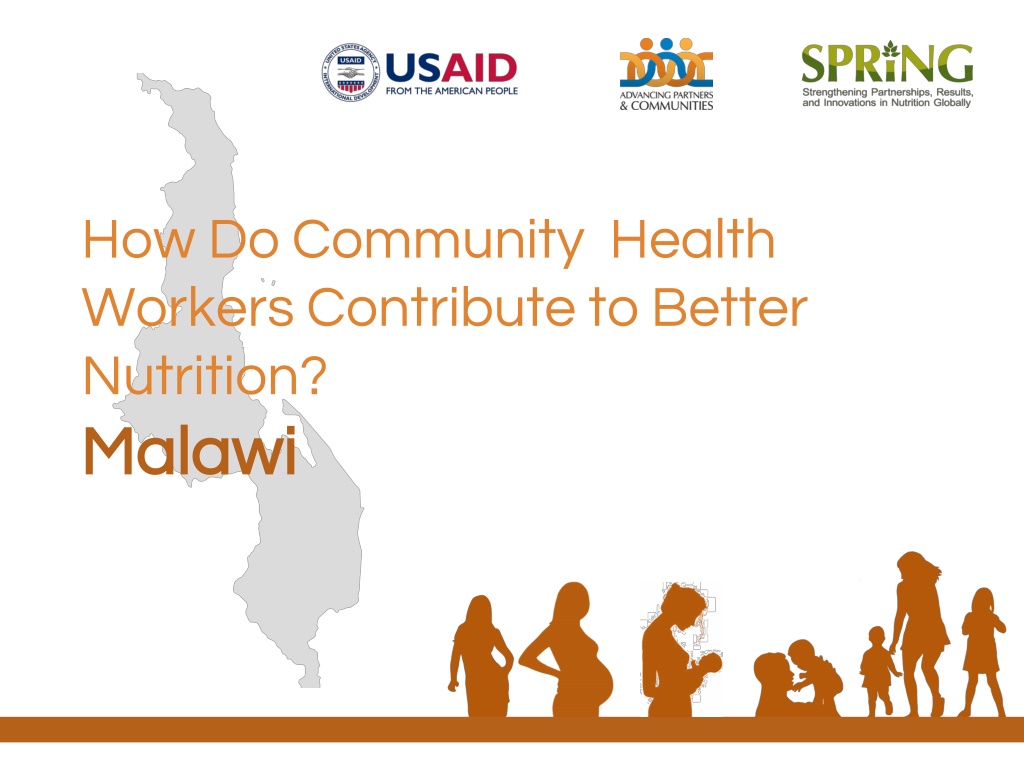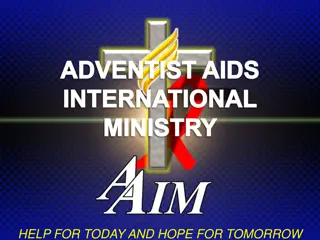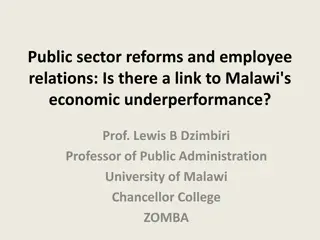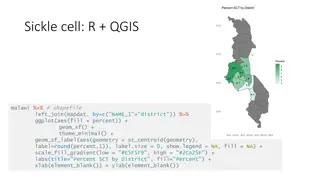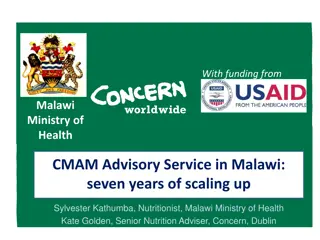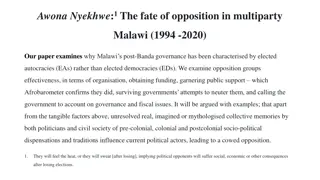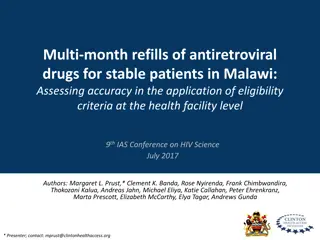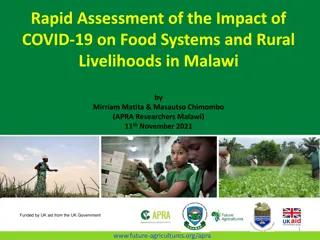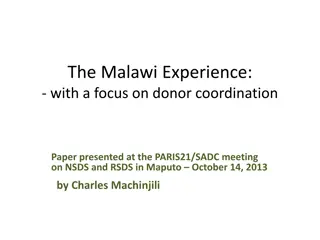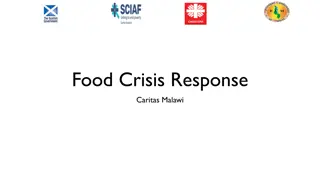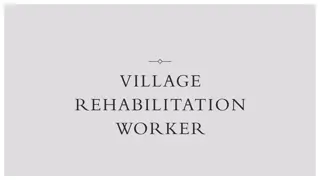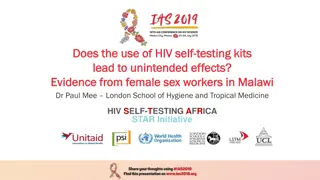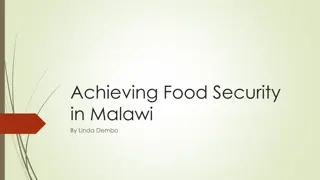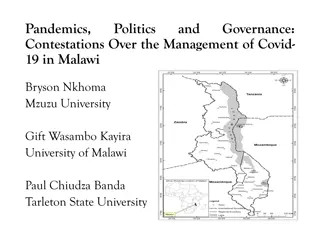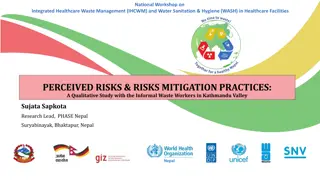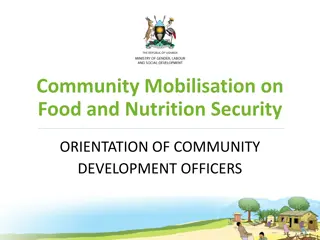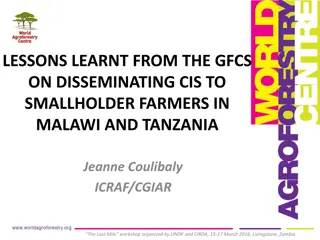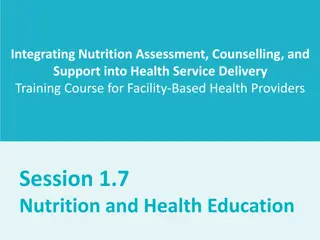Community Health Workers' Role in Improving Nutrition in Malawi
Community Health Workers in Malawi play a vital role in promoting better nutrition outcomes through their efforts in scaling up high-impact nutrition practices. By providing essential services and support, they contribute to enhancing maternal and child nutrition, ultimately improving the overall health of communities.
Download Presentation

Please find below an Image/Link to download the presentation.
The content on the website is provided AS IS for your information and personal use only. It may not be sold, licensed, or shared on other websites without obtaining consent from the author. Download presentation by click this link. If you encounter any issues during the download, it is possible that the publisher has removed the file from their server.
E N D
Presentation Transcript
How Do Community Health Workers Contribute to Better Nutrition? Malawi Malawi
About SPRING About SPRING The Strengthening Partnerships, Results, and Innovations in Nutrition Globally (SPRING) project is a five-year USAID-funded Cooperative Agreement to strengthen global and country efforts to scale up high-impact nutrition practices and policies and improve maternal and child nutrition outcomes. The project is managed by JSI Research & Training Institute, Inc., with partners Helen Keller International, The Manoff Group, Save the Children, and the International Food Policy Research Institute. About APC About APC Advancing Partners & Communities (APC) is a five-year cooperative agreement funded by the U.S. Agency for International Development under Agreement No. AID-OAA-A-12-00047, beginning. APC is implemented by JSI Research & Training Institute, Inc., in collaboration with FHI 360. The project focuses on advancing and supporting community programs that seek to improve the overall health of communities and achieve other health-related impacts, especially in relationship to family planning. APC provides global leadership for community-based programming, executes and manages small-and medium-sized sub-awards, supports procurement reform by preparing awards for execution by USAID, and builds technical capacity of organizations to implement effective programs. Disclaimer Disclaimer This report is made possible by the generous support of the American people through the United States Agency for International Development (USAID) under the terms of the Cooperative Agreement AID-OAA-A-11-00031 (SPRING), managed by JSI Research & Training Institute, Inc. (JSI). The contents are the responsibility of JSI and do not necessarily reflect the views of USAID or the United States Government. Recommended Citation Recommended Citation SPRING and APC. 2016. How Do Community Health Workers Contribute to Better Nutrition?: Malawi. Arlington, VA: Strengthening Partnerships, Results, and Innovations in Nutrition Globally (SPRING) project. SPRING SPRING JSI Research & Training Institute, Inc. 1616 Fort Myer Drive, 16th Floor Arlington, VA 22209 USA Phone: 703-528-7474 Fax: 703-528-7480 Email: info@spring-nutrition.org Internet: www.spring-nutrition.org
How to use these slides We invite in-country stakeholders to use this information to: Identify Identify which nutrition-related services CHWs can provide, according to policies; Prioritize Prioritizeand/or reassign responsibilities to avoid overburdening CHWs; Build Build a stronger foundation of policies, tools, and systems for CHWs to conduct their work; Plan Plan additional support to CHWs; Design Design and conduct other in-depth assessments of community nutrition programs; Inform Inform program implementers to strengthen community health interventions. These were developed using information collected by APC, with input from SPRING, through a desk review of existing policies and documents related to community health systems. Due to the diversity and magnitude of community health programs in a given country, we collected information based on country policies/strategies that comprise the key areas of a community health system and not the realities of program implementation. Due to funding and timing, we focused on national public sector programs, and only when possible, captured community-based privatesector health programsoperatingat scale.We encourageupdatesand validationto specificlocal contexts.
In Malawi, nutrition nutrition- -related health issues related health issues persist. According to most recent data, stunting remains a major challenge in Malawi. stunting 48% 48% % children under 5 of women of reproductive age have anemia 53 53 49 48 42 That means 984 thousand 984 thousand Malawian women have a critical micronutrient deficiency (2011) 2004 2006 2009 2010 2014 Anemia Anemia also persists as a major issue for Malawi s children. only only 19% 19% of children 6 23 months of age receive a minimum acceptable diet (2015) 73 71.7 % children under 5 68.4 67 65.6 2004 2006 2009 2010 2011 Source: World Bank Databank:
We know evidence interventions interventions can improve nutrition outcomes. evidence- -based, cost based, cost- -effective effective It is estimated that the following 10 evidence-based, nutrition-specific interventions, if scaled to 90 percent coverage, could reduce stunting by 20 percent percent and severe wasting by 60 percent severe wasting by 60 percent. reduce stunting by 20 Management of severe acute malnutrition Preventive zinc supplementation Promotion of breastfeeding Appropriate complementary feeding Management of moderate acute malnutrition Periconceptualfolic acid supplementation or fortification Maternal balanced energy protein supplementation Maternal multiple micronutrient supplementation Vitamin A supplementation Maternal calcium supplementation Source: Bhutta et al. 2013.
Studies have demonstrated the effectiveness of community health workers in achieving demonstrable health benefits directly related to the Millennium Development Goals (MDGs), including reducing child reducing child malnutrition and both child and malnutrition and both child and maternal mortality. maternal mortality. - Perry and Zulliger (2012)
Community health workers Community health workers play a critical role providing these proven, evidence-based, cost- effective interventions. play a critical role in By making basic primary care available at the community level, CHWs make it possible for women and children to receive the services they need for better health outcomes. Frequently based in the communities where they are from, community health workers (CHWs) have direct access to the community and can link with other nutrition-related community- based service providers. They can provide clients with a range of services such as medical care, information, counseling, and referral. However, CHWs are often expected to carry out a wide range of interventions with limited time, resources, and remuneration. They need appropriate academic curricula, training programs, and support systems including systems for monitoring, supporting, and mentoring. Countries like Malawi into consideration as they scale up and expand the services provided by CHWs. Malawi must take this
Informa Informati tion workers provide and the systems that support them in doing their work is often hard to find is often hard to find. on on the services that community health To begin to fill this void, the two USAID-funded projects - Advancing Partners and Communities (APC) Advancing Partners and Communities (APC) andStrengthening Partnerships , Results, and Innovations in Nutrition Globally Partnerships , Results, and Innovations in Nutrition Globally (SPRING) (SPRING) - - collaborated to conduct a desk review of existing policies and documents related to community health systems. Strengthening Due to the diversity and magnitude of community health programs in a given country, we collected information based on individual country policies/strategies that comprise the key areas of a community health system and not the realities of program implementation. Due to funding and timing, we focused on national public sector programs, and only when possible, captured community-based private sector health programs operating at scale.
These are our findings: This is what community health workers can do in Malawi, according to government policy. See the Data Notes at the end for more on how data were collected and analyzed.
Community health service delivery in Malawi is guided by multiple policies. multiple policies. Relevant Government Policies Reviewed Last Updated Malawi Heath Sector Strategic Plan 2011-2016 2011 Handbook and Guide for Health Providers on the Essential Health Package in Malawi 2011 Health Promotion Policy 2013 Human Resources for Health Strategic Plan 2007-2011 Unavailable Malawi Growth and Development Strategy II 2011-2016 2011 National Health Surveillance Assistant Programme of Malawi 2013
Malawi has seven distinct cadres seven distinct cadres of community health workers. We have information on nutrition services provided by three.* three.* 1. Health Surveillance Assistants (H 1. Health Surveillance Assistants (HSA array of promotive, preventive, and curative PHC services, maintain village registers, and conduct community mobilization activities. SA) ) provide an 13,500 13,500 in country** in country** 1 HSA :1,000 people (about 200 households) 2. 2. Community Leaders for Action on Nutrition (CLAN) Community Leaders for Action on Nutrition (CLAN) conduct nutrition-related activities with caregivers, like parents, in communities, with an emphasis on education, prevention, and monitoring of nutrition interventions. Number not available Number not available Information not available in policy Number not available Number not available Information not available in policy 3. 3. Natural Leaders (NL) Natural Leaders (NL) lead communities in becoming open-defecation free through community- led total sanitation efforts. * In addition, to these three cadres, there are Village Health Committee (VHC) members, Community Based Distribution Agent (CBDA), Community Home Based Care Volunteers (CHBCV), and Peer Educator (PE). However, we had no documentation of these cadres providing nutrition services. ** There is conflicting information about the recommended number of HSAs in the country; the HSSP indicates there should be 13,500 with a ratio of 1 HSA: 1,000 people, but the National Health Surveillance Assistant Programmeof Malawi recommends 27,000 to achieve the ideal ratio of 1 HSA: 500 people. The former is listed because the target ratio is expressed more explicitly in policy.
Community health workers in Malawi provide services in multiple health service delivery areas. multiple health service delivery areas. Services provided by CHWs Services not provided by CHWs Family planning Maternal and child health Integrated community case management HIV/AIDS Nutrition How is training training managed for CHW cadres? Malaria Tuberculosis National training National training curriculum curriculum is available Nutrition is included Nutrition is included in the training curriculum Immunization Water and sanitation
Community health workers in Malawi support improved nutrition outcomes throughout the continuum of care.
How we present our findings How we present our findings on nutrition services provided by community health workers. Services, listed in tables, are categorized as nutrition assessment counseling counseling, or support support actions. assessment, The tables presented for each stage of life across the continuum of care include specific nutrition- related services queried as part of the Community Health Systems Catalog Assessment. Assessment Activity / action to be taken Cadresof CHWs who conduct this task For each stage of life, we indicate if the service is provided by community health workers and which cadres have the responsibility to provide that service. Community health workers who provide services are identified by cadre: HSA HSA-Health Surveillance Assistant CLAN CLAN-Community Leader for Action on Nutrition NL NL-Natural Leader Counseling Support Service not provided by CHWs or not clearly specified in policy Services provided by CHWs
For adolescents Counseling Provide information/education/counseling (IEC) on iron/folate for women who are not pregnant and adolescent girls -- Support Provide/administer iron/folate for women who are not pregnant and adolescent girls --
For pregnant women Assessment Monitor weight gainduring pregnancy -- Measure mid-upperarm circumference (MUAC) screening for pregnant women -- Give information on hemoglobintesting for women who are pregnant -- Test blood for hemoglobin levels -- Counseling Provide IEC on nutrition/dietarypractices during pregnancy HSA Provide IEC on iron/folate HSA Provide IEC on insecticide-treated net use HSA Support Provide/administer insecticide-treated nets HSA Provide/administeriron/folate --
For breastfeeding women Assessment Monitor nutritional status of women who are breastfeeding (e.g., using MUAC) -- Counseling Provide IEC on correct positioning and attachment of the newborn during breastfeeding HSA Provide IEC on managing breastfeeding problems (breast health, perceptions of insufficient breast milk, etc.) HSA Provide IEC on nutrition/dietary practices during lactation HSA
For newborns Assessment Weighnewborns HSA Counseling Provide IEC on skin-to-skin contact between baby and mother/caregiver HSA Provide IEC on breastfeeding within 1 hour of birth HSA
For children Counseling Assessment Provide IEC on VitaminA for children 6 59 months of age Scales to measure weight of children up to 2 years of age HSA/CLAN HSA/CLAN Provide IEC on generalmicronutrient supplementation Use length boards to measure length of children up to 2 years of age HSA HSA/CLAN Provide IEC on de-worming medication Measure MUAC of children HSA/CLAN HSA/CLAN Screen children for bilateral edema Provide IEC on complementary feeding practices and continued breastfeeding (6 23 months of age) HSA/CLAN HSA/CLAN Support ProvideIEC on exclusive breastfeeding (first 6 months of age) HSA/CLAN Provide/administerVitamin A supplementation for children 6 59 months of age Provide IEC on introduction of soft, semi-solid foods at 6 months of age HSA HSA/CLAN ProvideIEC on continuing breastfeeding for children less than 6 months of age who have diarrhea Provide/administermicronutrient supplementation HSA HSA Provide/administerdeworming medication HSA Provide IEC on increasing fluids and continuing solid feeding for children over 6 months of age with diarrhea HSA Treating moderate acute malnutrition for children under 2 years of age HSA Treat severeacute malnutrition with ready-to-use therapeutic foods (RUTF) or ready-to-use supplementary foods (RUSF) HSA
For all stages of life Counseling Provide IEC on handwashing with soap HSA ProvideIEC on community-level total sanitation HSA / NL Provide IEC on household point-of-use water treatment HSA / CLAN
Our key takeaways In Malawi, three cadres of community health workers provide 30 30 of the recommended 38 nutrition services discussed in this assessment. 38 Adolescents Services provided by CHWs Pregnant women Service not provided by CHWs or not clearly specified in policy Breastfeeding women Newborns Children All stages of life
How to use this information You can use the data we have presented here to: Identify Identify which nutrition-related services CHWs can provide, according to policies; Prioritize Prioritizeand/or reassign responsibilities to avoid overburdening CHWs; Build Build a stronger foundation of policies, tools, and systems for CHWs to conduct their work; Plan Plan additional support to CHWs; Design Design and conduct other in-depth assessments of community nutrition programs; Inform Inform program implementers to strengthen community health interventions.
Data Notes This effort was undertaken as part of the wider Community Health Systems Catalog data collection effort. This document includes rich information about community-level nutrition policies and services in Malawi. The data represented here are based on a detailed analysis of survey responses and a review of select policies related to nutrition responsibilities of community health workers. You can find more details on the Community Health System in Malawi and data on other countries at: www.advancingpartners.org/ resources/chsc The data come with their own caveats. Policies do not always specify which particular actions CHWs are allowed or expected to perform, nor do they give any real indication of what actions CHWs actually do perform. Policies can be general, ambiguous, and/or contradictory. For instance, a policy might list "referral for antibiotics" but it doesn't specify which antibiotics. You can learn more about how to map health workforce activities with the SPRING Nutrition Workforce Mapping Toolkit, available at spring-nutrition.org/publications/tools/nutrition- workforce-mapping-toolkit
References Bhutta, Zulfiqar A., Jai K. Das, Arjumand Rizvi, Michelle F. Gaffey, Neff Walker, Susan Horton, Patrick Webb, Anna Lartey, Robert E. Black, The Lancet Nutrition Interventions Review Group, the Maternal and Child Nutrition Study Group. 2013. Evidence-based interventions for improvement of maternal and child nutrition: what can be done and at what cost? Lancet 382 (9890):452-477. doi:10.1016/S0140-6736(13)60996-4. (https://goo.gl/vxM6tT) Global Nutrition Report. 2015 Nutrition Country Profile, Malawi. 2015. (https://goo.gl/EQ69AD) World Bank DataBank. Health Nutrition and Population Statistics. 2016. World Bank Group: Washington, D.C. (https://goo.gl/9XOgGz) Perry, Roger and Rose Zulliger. 2012. How Effective Are Community Health Workers? An Overview of Current Evidence with Recommendations for Strengthening Community Health Worker Programs to Accelerate Progress in Achieving the Health-related Millennium Development Goals. JHU: Baltimore, MD. (https://goo.gl/ROLw6e)
Additional Resources on CHWs Community Health Systems Catalog Community Health Systems Catalog- An innovative and interactive reference tool on country community health systems intended for ministries of health, program managers, researchers, and donors interested in learning more about the current state of community health systems. (https://goo.gl/N1QKYK ) Essential Package of Health Services Country Snapshot Series Essential Package of Health Services Country Snapshot Series - A series of country profiles that analyzes the governance dimensions of Essential Packages of Health Services (EPHS), including how government policies contribute to the service coverage, population coverage, and financial coverage of the package (https://goo.gl/2M6FXr) Community Health Worker (CHW) Central Community Health Worker (CHW) Central- An online community of practice for sharing resources and experiences and discussing questions and ideas on CHW programs and policy. (https://goo.gl/dacnl5) The Community Health Framework The Community Health Framework- A framework developed for government decision makers to structure dialogues, answer questions, develop recommendations, and foster continuous learning about community health. (https://goo.gl/VZImbm) Global Experience of Community Health Workers for Delivery of Health Related Millennium Development Goals: A Systematic Revie Global Experience of Community Health Workers for Delivery of Health Related Millennium Development Goals: A Systematic Review, Country Case Studies, and Recommendations for Integration into National Health Systems Country Case Studies, and Recommendations for Integration into National Health Systems - A systematic review of CHW programs and their impact on health-related Millennium Development Goals (MDGs) as well as eight in-depth country case studies in Sub- Saharan Africa (Ethiopia Mozambique and Uganda), South East Asia (Bangladesh, Pakistan and Thailand) and Latin America (Brazil and Haiti). (https://goo.gl/5G0Vbc) w, How Effective Are Community Health Workers? An Overview of Current Evidence with Recommendations for Strengthening How Effective Are Community Health Workers? An Overview of Current Evidence with Recommendations for Strengthening Community Health Worker Programs to Accelerate Progress in Achieving the Health Community Health Worker Programs to Accelerate Progress in Achieving the Health- -related Millennium Development Goals update and supplementto the previous paper on the effectiveness of CHWs in providing a range of health services and improving health and nutrition outcomes. (https://goo.gl/jKx2Zg) related Millennium Development Goals - An
Additional Resources from Malawi Malawi: Nutrition Profile Malawi: Nutrition Profile USAID is prioritizing our nutrition efforts on focus countries where there is high burden of stunting and the Rome Principles, including country ownership and coordination, can be realized in practice. (https://goo.gl/KrKOfp) Motivation and job satisfaction of Health Surveillance Assistants in Mwanza, Malawi: an explorative study Motivation and job satisfaction of Health Surveillance Assistants in Mwanza, Malawi: an explorative study A qualitative assessment used to identify factors that influence motivation and job satisfaction of health surveillance assistant (HSAs) in Mwanza district, Malawi. The results of this assessment can be used to inform development strategies for better performance from HSAs, and create a more effective health system in Malawi. (https://goo.gl/ZEILY9) Health surveillance assistants as intermediates between the community and health sector in Malawi: exploring how Health surveillance assistants as intermediates between the community and health sector in Malawi: exploring how relationships influence performance relationships influence performance The roles of CHWs is defined by interpersonal relationships. As intermediaries between communities and the health sector, there is increasing global interest in how to support them. This study was created to obtain in depth insight into the facilitators of and barrier to the creation of interpersonal relationships between HSAs and other community actors. (https://goo.gl/7EpGDx) Community health worker incentives: Lessons learned and best practices from Malawi Community health worker incentives: Lessons learned and best practices from Malawi Despite Malawi s progress in recent years, many health challenges still remain, and child death due to preventable diseases remains high. Through more than 3,000 village health clinics targeting hard to reach areas, CHW s and volunteers are providing promotive, preventive and curative health services. (https://goo.gl/wHcedz) Strengthening Systems for Improved Nutrition Care, Support, and Treatment in Malawi Strengthening Systems for Improved Nutrition Care, Support, and Treatment in Malawi This technical report describes how USAID ASSIST worked with teams of district coaches and facility-based health care workers in eight facilities to apply a quality improvement approach to integrate nutrition services in HIV care. To improve outcomes, the teams worked to link clients with community-based nutritional or livelihood support. (https://goo.gl/K6o8DT)
Learn more at: www.spring-nutrition.org
